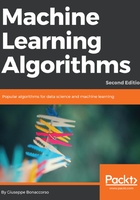
Computational neuroscience
It's not surprising that many machine learning algorithms have been defined and refined thanks to the contribution of research in the field of computational neuroscience. On the other hand, the most diffused adaptive systems are the animals, thanks to their nervous systems, that allow an effective interaction with the environment. From a mechanistic viewpoint, we need to assume that all the processes working inside the gigantic network of neurons are responsible for all computational features, starting from low-level perception and progressing until the highest abstractions, like language, logic reasoning, artistic creation, and so forth.
At the beginning of 1900, Ramón y Cajal and Golgi discovered the structure of the nerve cells, the neurons, but it was necessary to fully understand that their behavior was purely computational. Both scientists drew sketches representing the input units (dendrites), the body (soma), the main channel (axon) and the output gates (synapses), however neither the dynamic nor the learning mechanism of a cell group was fully comprehended. The neuroscientific community was convinced that learning was equivalent to a continuous and structural change, but they weren't able to define exactly what was changing during a learning process. In 1949, the Canadian psychologist Donald Hebb proposed his famous rule (a broader discussion can be found in Mastering Machine Learning Algorithms, Bonaccorso G., Packt Publishing, 2018 and Theoretical Neuroscience, Dayan P., Abbott L. F., The MIT Press, 2005) that is focused on the synaptic plasticity of the neurons. In other words, the changing element is the number and the nature of the output gates which connect a unit to a large number of other neurons. Hebb understood that if a neuron produces a spike and a synapse propagates it to another neuron which behaves in the same way, the connection is strengthened, otherwise, it's weakened. This can seem like a very simplistic explanation, but it allows you to understand how elementary neural aggregates can perform operations such as detecting the borders of an object, denoising a signal, or even finding the dimensions with maximum variance (PCA).
The research in this field has continued until today, and many companies, together with high-level universities, are currently involved in studying the computational behavior of the brain using the most advanced neuroimaging technologies available. The discoveries are sometimes surprising, as they confirm what was only imagined and never observed. In particular, some areas of the brain can easily manage supervised and unsupervised problems, while others exploit reinforcement learning to predict the most likely future perceptions. For example, an animal quickly learns to associate the sound of steps to the possibility of facing a predator, and learns how to behave consequently. In the same way, the input coming from its eyes are manipulated so as to extract all those pieces of information that are useful to detect the objects. This denoising procedure is extremely common in machine learning and, surprisingly, many algorithms achieve the same goal that an animal brain does! Of course, the complexity of human minds is beyond any complete explanation, but the possibility to double-check these intuitions using computer software has dramatically increased the research speed. At the end of this book, we are going to discuss the basics of deep learning, which is the most advanced branch of machine learning. However, I invite the reader to try to understand all the dynamics (even when they seem very abstract) because the underlying logic is always based on very simple and natural mechanisms, and your brain is very likely to perform the same operations that you're learning while you read!